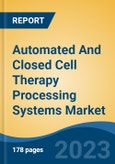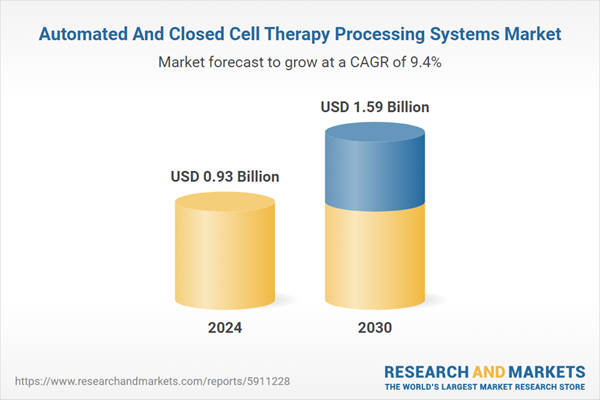Speak directly to the analyst to clarify any post sales queries you may have.
10% Free customizationThis report comes with 10% free customization, enabling you to add data that meets your specific business needs.
Key Market Drivers
Growing Popularity of Regenerative Medicine and Cell Therapies
Regenerative medicine and cell therapies represent a groundbreaking frontier in modern healthcare, offering new hope for treating a variety of challenging medical conditions. As these therapies gain momentum and continue to demonstrate their effectiveness, they are poised to significantly impact the healthcare industry. One crucial factor enabling the scalability and efficiency of regenerative medicine and cell therapy production is the adoption of automated and closed cell therapy processing systems.The increasing popularity of regenerative medicine and cell therapies has led to a surge in demand for these groundbreaking treatments. However, with greater demand comes the need for efficient, scalable, and consistent manufacturing processes. Automated and closed cell therapy processing systems offer a solution to this challenge. They can handle large-scale production while maintaining precise control over cell culture conditions.
This scalability is essential to meet the growing global demand for these therapies. In June 2024, Cryoport Systems, LLC joined forces with Minaris Regenerative Medicine to advance the development of cell and gene therapies. This partnership is centered on offering integrated solutions for the storage, transportation, and processing of cell and gene-based products. The collaboration aims to facilitate the commercialization and clinical trials of regenerative therapies.
Key Market Challenges
High Initial Costs
One of the most significant barriers to the adoption of automated cell therapy processing systems is the high initial cost associated with acquiring and implementing these advanced technologies. The investment required to purchase, install, and configure such systems can be substantial, often running into the millions of dollars. This poses a particular challenge for smaller biotech companies and research institutions that may lack the financial resources to make such large investments. Additionally, the long-term return on investment (ROI) may not be immediately clear, leading to hesitation among potential stakeholders. The financial strain associated with these initial costs can deter many from entering the market or adopting these systems, despite the potential long-term benefits in terms of efficiency, scalability, and precision.Key Market Trends
Increasing Adoption of Automated Systems for Efficiency and Consistency
The demand for automated cell therapy processing systems is rising globally due to the need for increased efficiency and consistency in manufacturing processes. Cell therapy, which includes innovative treatments such as stem cell and gene therapies, has complex production requirements that necessitate precise control over various parameters, including temperature, oxygen levels, and pH. Traditionally, manual processing could result in variability and human error, which compromises product quality and consistency. Automated systems are designed to standardize processes and reduce errors, ensuring more reliable outcomes.Key Market Players
- Miltenyi Biotec B.V. & Co. KG
- Lonza Group AG
- Fresenius Kabi AG
- Global Life Sciences Solutions USA LLC
- BioSpherix, LLC
- Terumo Corp
- Sartorius AG
- ThermoGenesis Holdings Inc
- Cellares Corporation
- Thermo Fisher Scientific Inc.
Report Scope:
In this report, the Global Automated And Closed Cell Therapy Processing Systems Market has been segmented into the following categories, in addition to the industry trends which have also been detailed below:Automated And Closed Cell Therapy Processing Systems Market, By Workflow:
- Separation
- Expansion
- Apheresis
- Fill-Finish
- Cryopreservation
- Others
Automated And Closed Cell Therapy Processing Systems Market, By Type:
- Stem Cell Therapy
- Non-Stem Cell Therapy
Automated And Closed Cell Therapy Processing Systems Market, By Scale:
- Pre-commercial/ R&D Scale
- Commercial Scale
Automated And Closed Cell Therapy Processing Systems Market, By Region:
- North America
- United States
- Canada
- Mexico
- Europe
- Germany
- United Kingdom
- France
- Italy
- Spain
- Asia-Pacific
- China
- Japan
- India
- Australia
- South Korea
- South America
- Brazil
- Argentina
- Colombia
- Middle East & Africa
- South Africa
- Saudi Arabia
- UAE
Competitive Landscape
Company Profiles: Detailed analysis of the major companies present in the Global Automated And Closed Cell Therapy Processing Systems Market.Available Customizations:
With the given market data, the publisher offers customizations according to a company's specific needs. The following customization options are available for the report.Company Information
- Detailed analysis and profiling of additional market players (up to five).
This product will be delivered within 1-3 business days.
Table of Contents
Companies Mentioned
- Miltenyi Biotec B.V. & Co. KG
- Lonza Group AG
- Fresenius Kabi AG
- Global Life Sciences Solutions USA LLC
- BioSpherix, LLC
- Terumo Corp
- Sartorius AG
- ThermoGenesis Holdings Inc
- Cellares Corporation
- Thermo Fisher Scientific Inc
Table Information
| Report Attribute | Details |
|---|---|
| No. of Pages | 180 |
| Published | February 2025 |
| Forecast Period | 2024 - 2030 |
| Estimated Market Value ( USD | $ 0.93 Billion |
| Forecasted Market Value ( USD | $ 1.59 Billion |
| Compound Annual Growth Rate | 9.3% |
| Regions Covered | Global |
| No. of Companies Mentioned | 10 |









